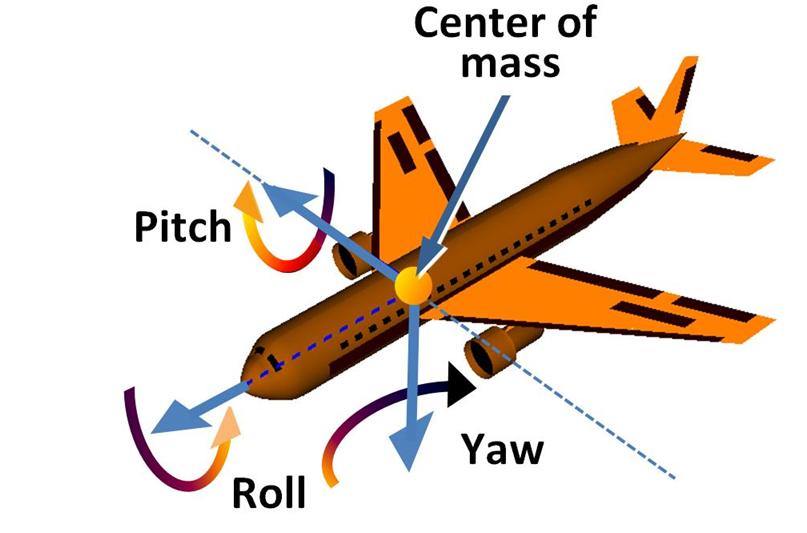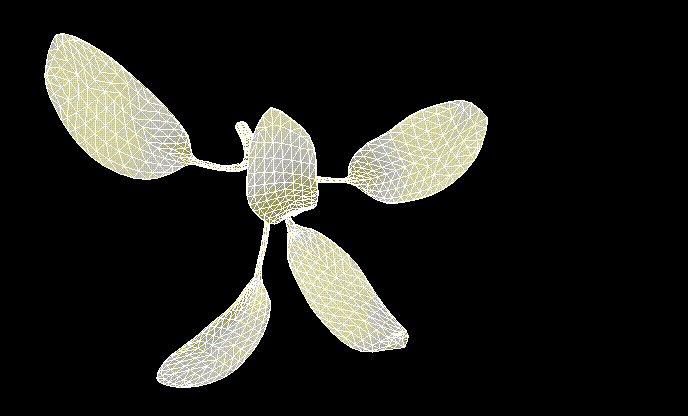转‘OpenGl鼠标控制摄像机camera实现三维漫游
2013-12-17 12:30
441 查看
目录(?)[+]
之前我们也学习过一个相关的函数,glLookAt,用来制定摄像机的位置,摄像机观察目标位置,还有摄像机的放置方式,我们可以通过不断地调用这个函数来实现3D漫游,但更方便的是抽象出一个摄像机类,实现一些摄像机的方法。
1) 相机注视的向量N
2) 相机的上方向向量V
3) 相机的右方向向量U
如下图,是在世界坐标系下的UVN相机的向量表示:

绿色轴为N,蓝色轴为V,红色轴为U。
当要改变相机位置和朝向的时候,只需要将uvn矩阵和相应的变换矩阵相乘即可。
mkdir build
cd build
cmake ..
sudo make install
写一个头文件:
eigen.h
[cpp] view
plaincopy
#ifndef EIGEN_H
#define EIGEN_H
#include "eigen3/Eigen/Dense"
#include "eigen3/Eigen/LU"
#include "eigen3/Eigen/Core"
#endif // EIGEN_H
放在工程目录下面,使用的时候包含进来就可以了。
看类声明:glcamera.h
[cpp] view
plaincopy
#ifndef GLCAMERA_H
#define GLCAMERA_H
#include "eigen.h"
#include <GL/glu.h>
#include <iostream>
using namespace Eigen;
class GLCamera
{
public:
GLCamera();
GLCamera(const Vector3d& pos, const Vector3d& target, const Vector3d& up);
void setModelViewMatrix();
void setShape(float viewAngle,float aspect,float Near,float Far);
void slide(float du, float dv, float dn);
void roll(float angle);
void yaw(float angle);
void pitch(float angle);
float getDist();
private:
Vector3d m_pos;
Vector3d m_target;
Vector3d m_up;
Vector3d u,v,n;
};
#endif // GLCAMERA_H
setModelViewMatrix:加载将当前MV矩阵。
setShape:设置摄像机的视角。
roll,yaw,pitch相当于绕N,V,U轴的旋转,如下图:

下面是相机的实现:
[cpp] view
plaincopy
#include "glcamera.h"
GLCamera::GLCamera()
{
}
GLCamera::GLCamera(const Vector3d &pos, const Vector3d &target, const Vector3d &up)
{
m_pos = pos;
m_target = target;
m_up = up;
n = Vector3d( pos.x()-target.x(), pos.y()-target.y(), pos.z()-target.z());
u = Vector3d(up.cross(n).x(), up.cross(n).y(), up.cross(n).z());
v = Vector3d(n.cross(u).x(),n.cross(u).y(),n.cross(u).z());
n.normalize();
u.normalize();
v.normalize();
setModelViewMatrix();
}
void GLCamera::setModelViewMatrix()
{
double m[16];
m[0]=u.x(); m[4]=u.y(); m[8]=u.z(); m[12]=-m_pos.dot(u);
m[1]=v.x(); m[5]=v.y(); m[9]=v.z(); m[13]=-m_pos.dot(v);
m[2]=n.x(); m[6]=n.y(); m[10]=n.z(); m[14]=-m_pos.dot(n);
m[3]=0; m[7]=0; m[11]=0; m[15]=1.0;
glMatrixMode(GL_MODELVIEW);
glLoadMatrixd(m); //用M矩阵替换原视点矩阵
}
void GLCamera::setShape(float viewAngle, float aspect, float Near, float Far)
{
glMatrixMode(GL_PROJECTION);
glLoadIdentity(); //设置当前矩阵模式为投影矩阵并归一化
gluPerspective(viewAngle,aspect, Near, Far); //对投影矩阵进行透视变换
}
void GLCamera::slide(float du, float dv, float dn)
{
//std::cout<<"u.x:"<<u.x()<<std::endl;
m_pos(0) = m_pos(0) + du*u.x()+dv*v.x()+dn*n.x();
m_pos(1) = m_pos(1) + du*u.y() +dv*v.y()+dn*n.y();
m_pos(2) = m_pos(2) + du*u.z()+dv*v.z()+dn*n.z();
m_target(0) = m_target(0)+du*u.x()+dv*v.x()+dn*n.x();
m_target(1) = m_target(0)+du*u.y()+dv*v.y()+dn*n.y();
m_target(2) = m_target(0)+du*u.z()+dv*v.z()+dn*n.z();
setModelViewMatrix();
}
void GLCamera::roll(float angle)
{
float cs=cos(angle*3.14159265/180);
float sn=sin(angle*3.14159265/180);
Vector3d t(u);
Vector3d s(v);
u.x() = cs*t.x()-sn*s.x();
u.y() = cs*t.y()-sn*s.y();
u.z() = cs*t.z()-sn*s.z();
v.x() = sn*t.x()+cs*s.x();
v.y() = sn*t.y()+cs*s.y();
v.z() = sn*t.z()+cs*s.z();
setModelViewMatrix(); //每次计算完坐标轴变化后调用此函数更新视点矩阵
}
void GLCamera::pitch(float angle)
{
float cs=cos(angle*3.14159265/180);
float sn=sin(angle*3.14159265/180);
Vector3d t(v);
Vector3d s(n);
v.x() = cs*t.x()-sn*s.x();
v.y() = cs*t.y()-sn*s.y();
v.z() = cs*t.z()-sn*s.z();
n.x() = sn*t.x()+cs*s.x();
n.y() = sn*t.y()+cs*s.y();
n.z() = sn*t.z()+cs*s.z();
setModelViewMatrix();
}
void GLCamera::yaw(float angle)
{
float cs=cos(angle*3.14159265/180);
float sn=sin(angle*3.14159265/180);
Vector3d t(n);
Vector3d s(u);
n.x() = cs*t.x()-sn*s.x();
n.y() = cs*t.y()-sn*s.y();
n.z() = cs*t.z()-sn*s.z();
u.x() = sn*t.x()+cs*s.x();
u.y() = sn*t.y()+cs*s.y();
u.z() = sn*t.z()+cs*s.z();
setModelViewMatrix();
}
float GLCamera::getDist()
{
float dist = pow(m_pos.x(),2)+pow(m_pos.y(),2)+pow(m_pos.z(),2);
return pow(dist,0.5);
}
没什么好说的,都是矩阵的一些计算。
这样就可以将你的摄像机融入到OpenGL工程中了,比如说放进一个Qt的工程,用一个GLWifget类来显示OpenGL。
在initializeGL() 中,初始化camera
[cpp] view
plaincopy
Vector3d pos(0.0, 0.0, 12.0);
Vector3d target(0.0, 0.0, 0.0);
Vector3d up(0.0, 1.0, 0.0);
camera = new GLCamera(pos, target, up);
在paintGL的时候,设置当前矩阵:
[cpp] view
plaincopy
glLoadIdentity();
camera->setModelViewMatrix();
在resizeGL中调整视角:
[cpp] view
plaincopy
camera->setShape(45.0, (GLfloat)width/(GLfloat)height, 0.1, 100.0);
添加相应的鼠标事件:
[cpp] view
plaincopy
void GLWidget::mousePressEvent(QMouseEvent *event)
{
lastPos = event->pos();
}
void GLWidget::mouseMoveEvent(QMouseEvent *event)
{
int dx = event->x() - lastPos.x();
int dy = event->y() - lastPos.y();
if (event->buttons() & Qt::LeftButton)
{
RotateX(dx);
RotateY(dy);
}
else if(event->buttons() & Qt::RightButton)
{
camera->roll(dx);
//camera->pitch(dy);
//camera->slide(0,0,-dy);
}
else if(event->buttons() & Qt::MiddleButton)
{
camera->slide(-dx,dy,0);
}
lastPos = event->pos();
updateGL();
}
void GLWidget::RotateX(float angle)
{
float d=camera->getDist();
int cnt=100;
float theta=angle/cnt;
float slide_d=-2*d*sin(theta*3.14159265/360);
camera->yaw(theta/2);
for(;cnt!=0;--cnt)
{
camera->slide(slide_d,0,0);
camera->yaw(theta);
}
camera->yaw(-theta/2);
}
void GLWidget::RotateY(float angle)
{
float d = camera->getDist();
int cnt=100;
float theta=angle/cnt;
float slide_d=2*d*sin(theta*3.14159265/360);
camera->pitch(theta/2);
for(;cnt!=0;--cnt)
{
camera->slide(0,slide_d,0);
camera->pitch(theta);
}
camera->pitch(-theta/2);
}
效果就像这样(gif 有点大,耐心等待):

提要
3D游戏中最基本的一个功能就是3D漫游了,玩家可以通过键盘或者鼠标控制自己的视角。之前我们也学习过一个相关的函数,glLookAt,用来制定摄像机的位置,摄像机观察目标位置,还有摄像机的放置方式,我们可以通过不断地调用这个函数来实现3D漫游,但更方便的是抽象出一个摄像机类,实现一些摄像机的方法。
UVN相机
UVN使用三个相互垂直的向量来表示相机的位置与朝向:1) 相机注视的向量N
2) 相机的上方向向量V
3) 相机的右方向向量U
如下图,是在世界坐标系下的UVN相机的向量表示:

绿色轴为N,蓝色轴为V,红色轴为U。
当要改变相机位置和朝向的时候,只需要将uvn矩阵和相应的变换矩阵相乘即可。
代码实现
这里借助了一个第三方矩阵向量库 - eigen。Ubuntu下的安装的过程非常简单,下载源码之后,解压,cd进目录:mkdir build
cd build
cmake ..
sudo make install
写一个头文件:
eigen.h
[cpp] view
plaincopy
#ifndef EIGEN_H
#define EIGEN_H
#include "eigen3/Eigen/Dense"
#include "eigen3/Eigen/LU"
#include "eigen3/Eigen/Core"
#endif // EIGEN_H
放在工程目录下面,使用的时候包含进来就可以了。
看类声明:glcamera.h
[cpp] view
plaincopy
#ifndef GLCAMERA_H
#define GLCAMERA_H
#include "eigen.h"
#include <GL/glu.h>
#include <iostream>
using namespace Eigen;
class GLCamera
{
public:
GLCamera();
GLCamera(const Vector3d& pos, const Vector3d& target, const Vector3d& up);
void setModelViewMatrix();
void setShape(float viewAngle,float aspect,float Near,float Far);
void slide(float du, float dv, float dn);
void roll(float angle);
void yaw(float angle);
void pitch(float angle);
float getDist();
private:
Vector3d m_pos;
Vector3d m_target;
Vector3d m_up;
Vector3d u,v,n;
};
#endif // GLCAMERA_H
setModelViewMatrix:加载将当前MV矩阵。
setShape:设置摄像机的视角。
roll,yaw,pitch相当于绕N,V,U轴的旋转,如下图:

下面是相机的实现:
[cpp] view
plaincopy
#include "glcamera.h"
GLCamera::GLCamera()
{
}
GLCamera::GLCamera(const Vector3d &pos, const Vector3d &target, const Vector3d &up)
{
m_pos = pos;
m_target = target;
m_up = up;
n = Vector3d( pos.x()-target.x(), pos.y()-target.y(), pos.z()-target.z());
u = Vector3d(up.cross(n).x(), up.cross(n).y(), up.cross(n).z());
v = Vector3d(n.cross(u).x(),n.cross(u).y(),n.cross(u).z());
n.normalize();
u.normalize();
v.normalize();
setModelViewMatrix();
}
void GLCamera::setModelViewMatrix()
{
double m[16];
m[0]=u.x(); m[4]=u.y(); m[8]=u.z(); m[12]=-m_pos.dot(u);
m[1]=v.x(); m[5]=v.y(); m[9]=v.z(); m[13]=-m_pos.dot(v);
m[2]=n.x(); m[6]=n.y(); m[10]=n.z(); m[14]=-m_pos.dot(n);
m[3]=0; m[7]=0; m[11]=0; m[15]=1.0;
glMatrixMode(GL_MODELVIEW);
glLoadMatrixd(m); //用M矩阵替换原视点矩阵
}
void GLCamera::setShape(float viewAngle, float aspect, float Near, float Far)
{
glMatrixMode(GL_PROJECTION);
glLoadIdentity(); //设置当前矩阵模式为投影矩阵并归一化
gluPerspective(viewAngle,aspect, Near, Far); //对投影矩阵进行透视变换
}
void GLCamera::slide(float du, float dv, float dn)
{
//std::cout<<"u.x:"<<u.x()<<std::endl;
m_pos(0) = m_pos(0) + du*u.x()+dv*v.x()+dn*n.x();
m_pos(1) = m_pos(1) + du*u.y() +dv*v.y()+dn*n.y();
m_pos(2) = m_pos(2) + du*u.z()+dv*v.z()+dn*n.z();
m_target(0) = m_target(0)+du*u.x()+dv*v.x()+dn*n.x();
m_target(1) = m_target(0)+du*u.y()+dv*v.y()+dn*n.y();
m_target(2) = m_target(0)+du*u.z()+dv*v.z()+dn*n.z();
setModelViewMatrix();
}
void GLCamera::roll(float angle)
{
float cs=cos(angle*3.14159265/180);
float sn=sin(angle*3.14159265/180);
Vector3d t(u);
Vector3d s(v);
u.x() = cs*t.x()-sn*s.x();
u.y() = cs*t.y()-sn*s.y();
u.z() = cs*t.z()-sn*s.z();
v.x() = sn*t.x()+cs*s.x();
v.y() = sn*t.y()+cs*s.y();
v.z() = sn*t.z()+cs*s.z();
setModelViewMatrix(); //每次计算完坐标轴变化后调用此函数更新视点矩阵
}
void GLCamera::pitch(float angle)
{
float cs=cos(angle*3.14159265/180);
float sn=sin(angle*3.14159265/180);
Vector3d t(v);
Vector3d s(n);
v.x() = cs*t.x()-sn*s.x();
v.y() = cs*t.y()-sn*s.y();
v.z() = cs*t.z()-sn*s.z();
n.x() = sn*t.x()+cs*s.x();
n.y() = sn*t.y()+cs*s.y();
n.z() = sn*t.z()+cs*s.z();
setModelViewMatrix();
}
void GLCamera::yaw(float angle)
{
float cs=cos(angle*3.14159265/180);
float sn=sin(angle*3.14159265/180);
Vector3d t(n);
Vector3d s(u);
n.x() = cs*t.x()-sn*s.x();
n.y() = cs*t.y()-sn*s.y();
n.z() = cs*t.z()-sn*s.z();
u.x() = sn*t.x()+cs*s.x();
u.y() = sn*t.y()+cs*s.y();
u.z() = sn*t.z()+cs*s.z();
setModelViewMatrix();
}
float GLCamera::getDist()
{
float dist = pow(m_pos.x(),2)+pow(m_pos.y(),2)+pow(m_pos.z(),2);
return pow(dist,0.5);
}
没什么好说的,都是矩阵的一些计算。
这样就可以将你的摄像机融入到OpenGL工程中了,比如说放进一个Qt的工程,用一个GLWifget类来显示OpenGL。
在initializeGL() 中,初始化camera
[cpp] view
plaincopy
Vector3d pos(0.0, 0.0, 12.0);
Vector3d target(0.0, 0.0, 0.0);
Vector3d up(0.0, 1.0, 0.0);
camera = new GLCamera(pos, target, up);
在paintGL的时候,设置当前矩阵:
[cpp] view
plaincopy
glLoadIdentity();
camera->setModelViewMatrix();
在resizeGL中调整视角:
[cpp] view
plaincopy
camera->setShape(45.0, (GLfloat)width/(GLfloat)height, 0.1, 100.0);
添加相应的鼠标事件:
[cpp] view
plaincopy
void GLWidget::mousePressEvent(QMouseEvent *event)
{
lastPos = event->pos();
}
void GLWidget::mouseMoveEvent(QMouseEvent *event)
{
int dx = event->x() - lastPos.x();
int dy = event->y() - lastPos.y();
if (event->buttons() & Qt::LeftButton)
{
RotateX(dx);
RotateY(dy);
}
else if(event->buttons() & Qt::RightButton)
{
camera->roll(dx);
//camera->pitch(dy);
//camera->slide(0,0,-dy);
}
else if(event->buttons() & Qt::MiddleButton)
{
camera->slide(-dx,dy,0);
}
lastPos = event->pos();
updateGL();
}
void GLWidget::RotateX(float angle)
{
float d=camera->getDist();
int cnt=100;
float theta=angle/cnt;
float slide_d=-2*d*sin(theta*3.14159265/360);
camera->yaw(theta/2);
for(;cnt!=0;--cnt)
{
camera->slide(slide_d,0,0);
camera->yaw(theta);
}
camera->yaw(-theta/2);
}
void GLWidget::RotateY(float angle)
{
float d = camera->getDist();
int cnt=100;
float theta=angle/cnt;
float slide_d=2*d*sin(theta*3.14159265/360);
camera->pitch(theta/2);
for(;cnt!=0;--cnt)
{
camera->slide(0,slide_d,0);
camera->pitch(theta);
}
camera->pitch(-theta/2);
}
效果就像这样(gif 有点大,耐心等待):

参考
openGL中camera类的设计以及使用 - http://blog.csdn.net/hobbit1988/article/details/7956838相关文章推荐
- OpenGL实现的鼠标控制三维空间物体的移动
- 鼠标控制场景变化,将此脚本语言绑定在摄像机上然后选择参照模型实现
- 开源流媒体客户端EasyClient手机端控制摄像机EasyCamera云台PTZ控制实现
- 开源流媒体客户端EasyClient手机端控制摄像机EasyCamera云台PTZ控制实现
- 使用OpenGL实现三维坐标的鼠标拣选
- 使用OpenGL实现三维坐标的鼠标拣选(一 )
- 使用OpenGL实现三维坐标的鼠标拣选
- 使用OpenGL实现三维坐标的鼠标拣选( 二 )
- 【unity3D】鼠标控制camera的移动、放大(俯视浏览效果、LOL摄像机移动效果)
- OpenGL实现CS死后的摄像机漫游方式
- OpenGL: 实现三维坐标的鼠标拣选
- 使用OpenGL实现三维坐标的鼠标拣选
- 三维漫游控制方式与实现技术
- 基于EasyDarwin云平台实现的EasyClient客户端与EasyCamera摄像机之间的对讲与云台控制功能
- 三维漫游控制方式与实现技术
- 基于EasyDarwin云平台实现的EasyClient客户端与EasyCamera摄像机之间的对讲与云台控制功能
- 使用OpenGL实现三维坐标的鼠标拣选
- opengl实现鼠标控制和左右分屏观看全景图
- 使用OpenGL实现三维坐标的鼠标拣选(转)
- 使用OpenGL实现三维坐标的鼠标拣选(转)
